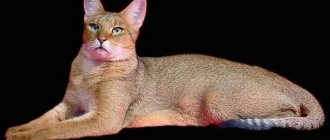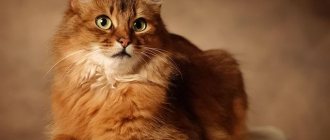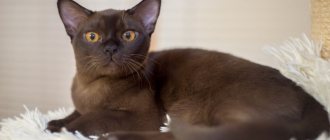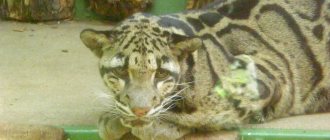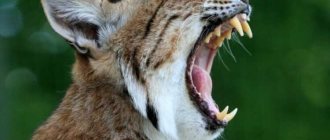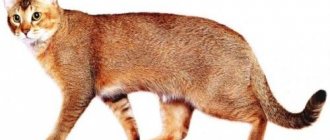Chausie are domesticated descendants of predatory inhabitants of swamps, rivers, and lakes. These proud creatures are the embodiment of animal energy, power, partly curbed by man. Such cats are more likely natural hunters than affectionate purrs. This is also facilitated by their charming appearance, which is distinguished by the special grace of a wild representative of the cat world. Due to its unusual exterior and combination of contradictory behavioral traits, the breed of reed cat descendants is considered one of the most expensive in the world.
History of the origin of Chausie cats
There is an assumption that the ancestors of the Chausie could have appeared in Ancient Egypt. The habitat of jungle cats is quite wide: from South to Central Asia. Some of them can be found in Africa, near the Nile. They mainly live on the sandy shores of water bodies.
The wild relatives of the Shawsie are not timid; they are absolutely not afraid of people and often coexist peacefully. Therefore, it is quite possible that long ago, domestic pets, walking with their wild counterparts, were fascinated by their natural magnetism and began to voluntarily enter into communication with them. As a result of their crossing in natural conditions, the first hybrids were born.
For a long time, the exotic heirs of jungle cats were not noticed. The Americans were the first to pay attention to the characteristics of cats, who in the late 1960s decided to breed a breed with the appearance of an obstinate “parent”, but with a softer, docile disposition of a tamed cat. It turned out that breeding Hausi is not an easy process.
But luck smiled on persistent enthusiasts. The new breed of cats was named after the wild “father” (the Latin name for reed predators is “Felis Chaus”). Now in their homeland, in the states, these cats are known and loved. In Russia and neighboring countries, on the contrary, there are very few of them.
The most productive period of felinologists’ work on the breed dates back to the 90s. matings of Chausie cats with Abyssinian cats and outbred shorthairs began Although now they are crossed with other domestic representatives. Thanks to this, American cats have a rich gene pool and strong immunity. The new breed of cats received official recognition in the early 2000s. Today they are bred in Europe and America.
Description of chausie
The tame predator looks like an Abyssinian on steroids. Cats of this breed are much larger than other cats. Sometimes their weight reaches 15 kg, but on average the pet’s weight is 7-10 kg. The body of males is more massive, but females are much more active.
The pets of this breed inherited the structural features from their “relatives” - savages. Chausie cats have an elongated, powerful, elegant body with a deep chest. The animal radiates with energy, making it look like a compressed spring. The limbs are tall, slender, strong with large pads. The hind legs are longer than the front legs, so these cats can jump up to 2 meters in height. But the thick tail turned out to be unexpectedly short relative to the length of the body.
A medium-sized, oval-shaped head with a developed chin and wide, slightly pointed cheekbones sits firmly on a stocky, muscular neck. The Egyptian gracefulness of the Chausie is partly due to its large ears and elongated, panther-like muzzle. The nose is straight and wide. The ears are large, set wide apart, pointed at the ends, and decorated with thin tassels.
According to the standard, Chausies have large, slightly slanted, round eyes. The amber tint of the iris looks the most beautiful and harmonious, but there are combinations of yellow and green shades. The eye color of exotic Americans contrasts favorably with the coat color.
The Hausi's fur coat is very short and full. The luxurious cover went to the marvelous descendants of wild cats from the Abyssinian breed. The fur is shiny, shimmering under the rays of the sun with warm, bright sparkles. It feels soft and elastic to the touch.
color palette does not offer much variety. The standard establishes only three acceptable shades of coat: black (with an admixture of gray), silver-brown ticked and dark ticked tabby. Due to the novelty of the breed, more and more different coat colors are appearing, but they are in no hurry to add them to the main ones. For this reason, such kittens cannot participate in exhibitions.
When buying a pet, there are a few more subtleties to consider. Firstly, regardless of coat color, the tuft on the tail and small bushes of hair on the tips of the ears should be exclusively black. Secondly, the pattern of the fur coat can be blurry, but the pattern on the tail, paws and head is clear, the neck and chest are usually decorated with a light shirt-front.
The most important factors determining the inherited exterior and character of a Hausie are the degree of relationship with the jungle cat and the percentage of its blood in the total volume.
For example,
- chausie F1 - at least 50% wild blood / father;
- chausie F2 - at least 25% / one of the progenitors - “savage”;
- chausie F3 - about 12.5%, etc.
The higher the indicator, the closer to the “roots” the pet is considered.
Appearance and character of Chausie
Description of the Chausie breed. Chausie kittens have inherited the intelligence of the Abyssinian cat and the size of wild cats.
- The weight of such a cat reaches 15 kg, and its dimensions can be compared with medium breed dogs.
- The body is muscular and proportional.
- They have short, smooth, shiny fur; the interesting thing is that the color can be uneven, but two-color or even three-color.
- The head is rounded, the ears are elongated, often with “tassels” at the ends. In females the bridge of the nose is narrow, in males it is wider.
- The eyes are slightly slanted and have iris colors ranging from copper to green shades. The tail is long, mobile and without bends.
There are three colors available:
- Black - uniform, without marks.
- Ticked tabby - the hairs have two or three colors, often this color is called Abyssinian.
- Ticked silver - the hairs of the coat consist of two or three colors of black and gray, the tips are always darker.
Cats of this breed are divided into several more types, which are called markings.
- F1 are the closest to their wild ancestors, they are descendants, have aggressive habits and are large in size.
- F2 - second generation. Outwardly, they are less reminiscent of jungle cats, but are still endowed with their character traits and are considered domestic.
- F3 are direct descendants of F2, similar in character to a domestic cat, but in appearance like a wild one.
- F4 - such a cat can already be safely called domestic, the share of its wild blood is less than 7%, which means that it is very distantly related to the jungle cat and has practically no habits.
Chausie kittens received the improved intelligence of the “Abyssinians” (many talk about the similarity of skills and consciousness of the Abyssinian breed and dogs). Smart animals that have a rebellious, independent character, but are absolutely affectionate when surrounded by family. Smart and active, they are always on the move.
Such a cat cannot be kept in closed small rooms, this will lead to your pet withering away. Chausie is perfectly trainable: it will be very easy to accustom her to a sleeping place or tray.
What distinguishes her from many other breeds is her love of water; she will enjoy washing and swimming. This breed gets along well only with animals of its own size; it perceives small rodents and birds as prey. Photos are needed to appreciate the beauty of these incredible cats.
Characteristics of the Chausie breed
Chausies are friendly, very sociable and moderately affectionate. Despite the fact that, according to experts, the character of cats is practically no different from the character of ordinary cats, they remain capricious and even obstinate. The degree of expression of this savage vein is influenced by the proximity of the reed “father” to the emerging offspring. So, today cats of the fourth generation are popular, which are considered more docile and suitable for keeping in the house.
From the Abyssinian, cats got not only a bewitching appearance, but also high intelligence. These animals are interested in everything new and enjoy training. Cat lovers recommend rewarding exemplary students with tasty bonuses. Chausies are very smart, cheerful and active.
Since childhood, they love to play, and with age they become more reasonable and a little calmer. A person who decides to let this pet puma into his life should remember that such a pet needs spacious premises for proper leisure. A cat will be comfortable in a private house with a small yard.
From the swamp “relatives” of the Chausie, a craving for constant exploration of the territory was passed on, if not to say hunting. They are inimitable jumpers and runners. In addition, representatives of the breed tend to make “stocks” - cats will secretly take away the thing they like and hide it. Therefore, when cleaning the apartment, the owner will regularly come across “stash”.
Like most cats, Chausies cannot stand being alone. Moreover, if a person is absent for a long time, no one can guarantee that the offended creature will not destroy the home. So, to avoid stress, it is better to have another four-legged family member. The Hausi are especially favorable towards cats and dogs.
Health and standard
If you are purchasing a pet not only with the goal of diversifying your life and making a friend, but also planning to take it to exhibitions, then you should know that there are quite strict standards for the Chausie.
Any deviation from the standard is a defect.
In most cases this is:
- Humpback
- Long neck
- Overly round head shape
- Small, close-set ears
- Short tail
- Deafness
- Undescended testicles
- Amputated claws
And this is only a small part of all deviations, defects and deformities for which people are disqualified from competitions and exhibitions.
If you only care about the health of your pet, then when purchasing, pay attention to the nose and eyes - they should be free of green, yellow and heavy discharge. The coat should not be dull, but rather soft and shiny.
Take a close look at the kitten's behavior; an active and playful mood should accompany a small Chausie breed. Despite the multifaceted crossing of different bloods in the breed, nature rewarded them with good health. Keep in mind that cats marked F1 and F2 cannot give birth, unlike F3 and F4.
Care and maintenance of Chausie cats
- Grooming
. In order to keep the coat in order, it is enough to comb the cat with a soft brush once a week. There are no recommendations at all on the frequency of bathing. But you need to wash your chausie at least to pamper him. After all, cats sincerely enjoy this process (they swim willingly). We must not forget about standard procedures: trimming nails, cleaning ears, periodically cleaning the corners of the eyes.
- Walks
. The animals described are left with an irresistible desire for a free life from their ancestors. They literally transform while playing outdoors. To release excess energy, sometimes destructive, exercise is recommended for Chausie cats.
- Nutrition
. Many Chausie cats cannot digest plant matter. As a result, the gastrointestinal tract becomes inflamed and the absorption of vitamins and minerals is impaired, leading to chronic malnutrition. Even dry food is contraindicated for them. Chausie cats have their own special diet - meat. All types of this product are allowed (with the exception of pork).
Chausie diseases
Felinologists took the breeding of the breed seriously and saturated the gene pool with the best material. These representatives of the cat world can boast of good health.
Pets from America Chausie live about 15-20 years.
However, there are several nuances:
- It is difficult to accustom the immediate descendants of reed inhabitants to a tray;
- Another unpleasant surprise is that the cats of the first two generations are sterile.
Maintenance and care of Chausie
Chausie does not require much care. For short hair, it is enough to brush it with a soft brush several times a month, but during periods of shedding it is recommended to brush it more often, mainly for the convenience of the owner.
- These cats will be happy with water procedures all the time; pour them warm water, and after bathing, prevent drafts.
- Clean your ears as they become dirty with a damp cotton pad or ear swab.
- Don't forget about oral hygiene.
- Trim the nails carefully, without touching the nerves (if this is your first pet, it is better to contact a veterinary clinic).
Chausies have a very delicate digestive system and a shortened intestinal tract, which they inherited from their wild ancestors. They cannot digest fiber and plant fibers.
Therefore, this breed prefers raw natural meat, sometimes fish, but not dry food. These cats are prone to overeating; carefully monitor their diet and food intake.
Conclusions about the breed
So, who should own a chausie and why?
- active family with other pets, but preferably without small children. They are kind, affectionate and obedient, but from time to time they are unpredictable and are able to show their ambition.
- owners of private houses. Chausies are excellent guards and hunters. Of course, they are not as good as dogs, but a mouse or an uninvited guest will definitely not get into your home.
- those who are not ready to spend significant sums of money on care and treatment of diseases. Only a few things (meat table, walks, bathing and socializing with people) are enough to make your pet happy.


